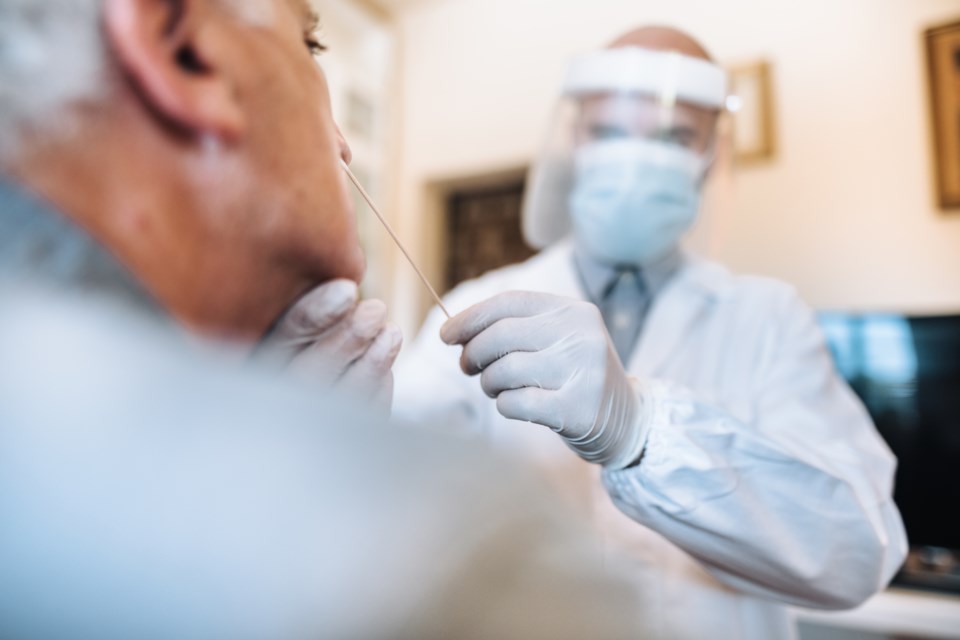Reported cases of the coronvirus variant Omicron in B.C. are delayed by several days, as health officials only publish results of a lengthier sequencing process.
The B.C. Centre for Disease Control (BCCDC) reports new Omicron cases using “whole-genome” sequencing, a process that can take up to a week, according to its website. This form of variant tracking allows scientists to map out the more than 30,000 genetic parts of the virus.
However, there's also a single-nucleotide polymorphism (SNP, or “snip”) test available for officials. This quicker test isolates only a small fraction of the genome, including the S-gene (spike protein which binds to human cells), known to contain a mutation of the variant that differs from the circulating strain.
While the snip tests take about 24 to 48 hours to identify a variant such as Omicron and could provide the public with a better overall picture of the variant’s spread, provincial health officer Dr. Bonnie Henry said this week those results are not reported publicly. She indicated the snip is not as definitive.
“So some parts of the country, they will report on the S-gene (spike protein) deletion, which is one sort of marker that it could be the Omicron variant and they report on that because that can be done very rapidly. We're not using that mostly here in B.C. We're using some snip testing, particularly the lab at St. Paul's, and then those go through confirmatory testing.
“So we are reporting on the proportion that are confirmed Omicron through the whole-genome sequencing, and that happens about every two days to three days,” added Henry. (The BCCDC says the process takes four to seven days.)
However, while Omicron data presented to the public comes with a greater delay than some other jurisdictions, Henry noted public health officials are nevertheless using snip results internally to get a better sense of the spread.
“Yes, we have a good sense from the lab of which ones are likely to be [Omicron] and that's why I can tell you that we're probably up to about 50% based on the early snip testing and the S-gene deletion in some other places,” said Henry Dec. 21 at a press conference.
Yet, reported Omicron cases are nowhere near that 50% level.
On Dec. 17, the Ministry of Health announced 167 new “identified” cases of Omicron (confirmed through whole-genome sequencing days after the fact). That’s more than double the total cases identified on Dec. 16: 135. On Dec. 21, the ministry reported 756 total “identified” Omicron cases.
And on Dec. 23, the ministry announced 975 “confirmed” Omicron cases — just 219 cases over two days when 3,530 total COVID-19 cases were reported.
But, if Henry’s assertion from internal snip test data holds that about 50% of cases are Omicron, the two-day total (Dec. 22-23) of Omicron would be 1,715.
Omicron is showing significant resistance to the vaccines — particularly in terms of spreading the virus and presenting mild cold and flu symptoms. On Dec. 23, an analysis done by an independent modelling group showed that the Omicron variant will put "extreme" demand on B.C. hospitals in January.
A peer-reviewed study from the COVID-19 Genomics UK Consortium in February concluded about SNP testing that, “the fast turnaround of this approach coupled with the ease with which it can be automated means that it has the potential to provide additional detail for epidemiological studies.”
“It is not, however a substitute for continued sequencing,” as whole-genome sequencing provides a full map of each specimen.
Dr. Terry Snutch, professor at Michael Smith Laboratories of the University of B.C. and chair of the Canadian COVID-19 Genome Network virus project, says the delays in reporting Omicron cases ultimately may not be consequential.
“At the end of the day, you know, it's not knowing necessarily exactly how many — I think people get hung up on numbers — it’s where are the trends of which variants and are those variants causing breakthrough infections in vaccinated or fully vaccinated or fully boostered people?” said Snutch.
He said all snip sequencing data is shared among health authorities on a daily basis, but it’s not published.
And so, with regard to making public health policy decisions,“I don't think that the information that Bonnie Henry is receiving is in any way, shape or form delayed,” said Snutch.
Furthermore, whole-genome sequencing is better, noted the doctor.
Snip testing “tells you positive, negative, and it gives you a strong indication as to which variant, but it doesn't give you exact information that you can use for tracking whether that particular strain or that particular sample, for example, was, you know, coming from an airplane arriving from Toronto or Montreal or came from South Africa. It's not accurate enough.”
Snutch said the time has passed in determining the rate of Omicron spread as it will quickly account for nearly all COVID-19 cases. (The province is expected to give an update on the Omicron situation Friday morning.)
However, such testing processes will likely come into play in the future; when asked about her goals in 2022, Henry said being able to respond to the potential for new variants of concern will be key in the ongoing pandemic response.
And to that end, Henry said public health labs are speeding up genome sequencing to detect and monitor virus strains.



